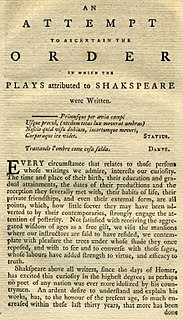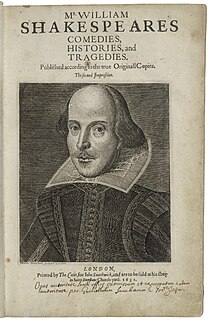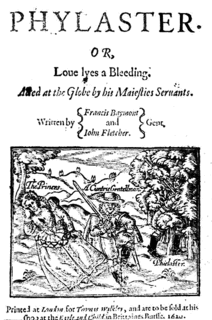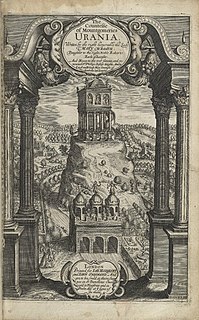Related Research Articles

The earliest texts of William Shakespeare's works were published during the 16th and 17th centuries in quarto or folio format. Folios are large, tall volumes; quartos are smaller, roughly half the size. The publications of the latter are usually abbreviated to Q1, Q2, etc., where the letter stands for "quarto" and the number for the first, second, or third edition published.

This article presents a possible chronological listing of the composition of the plays of William Shakespeare.

False Folio is the term that Shakespeare scholars and bibliographers have applied to William Jaggard's printing of ten Shakespearean and pseudo-Shakespearean plays together in 1619, the first attempt to collect Shakespeare's work in a single volume. There are only two complete extant copies. One is part of the collection of the Folger Shakespeare Library in Washington, DC. The other is held in the Special Collections at Texas Christian University in Fort Worth, Texas.

The Second Folio is the 1632 edition of the collected plays of William Shakespeare. It follows the First Folio of 1623. Much language was updated in the Second Folio and there are almost 1,700 changes.

Philaster, or Love Lies a-Bleeding is an early Jacobean era stage play, a tragicomedy written by Francis Beaumont and John Fletcher. One of the duo's earliest successes, the play helped to establish the trend for tragicomedy that was a powerful influence in early Stuart-era drama.
Thomas Creede was a printer of the Elizabethan and Jacobean eras, rated as "one of the best of his time." Based in London, he conducted his business under the sign of the Catherine Wheel in Thames Street from 1593 to 1600, and under the sign of the Eagle and Child in the Old Exchange from 1600 to 1617. Creede is best known for printing editions of works in English Renaissance drama, especially for ten editions of six Shakespearean plays and three works in the Shakespeare Apocrypha.
Robert Allot was a London bookseller and publisher of the early Caroline era; his shop was at the sign of the black bear in St. Paul's Churchyard. Though he was in business for a relatively short time – the decade from 1625 to 1635 – Allot had significant connections with the dramatic canons of the two greatest figures of English Renaissance theatre, William Shakespeare and Ben Jonson.
William Aspley was a London publisher of the Elizabethan, Jacobean, and Caroline eras. He was a member of the publishing syndicates that issued the First Folio and Second Folio collections of Shakespeare's plays, in 1623 and 1632.
John Smethwick was a London publisher of the Elizabethan, Jacobean, and Caroline eras. Along with colleague William Aspley, Smethwick was one of the "junior partners" in the publishing syndicate that issued the First Folio collection of Shakespeare's plays in 1623. As his title pages specify, his shop was "in St. Dunstan's Churchyard in Fleet Street, under the Dial."
Richard Meighen was a London publisher of the Jacobean and Caroline eras. He is noted for his publications of plays of English Renaissance drama; he published the second Ben Jonson folio of 1640/1, and was a member of the syndicate that issued the Second Folio of Shakespeare's collected plays in 1632.
Nathaniel Butter was a London publisher of the early 17th century. The publisher of the first edition of Shakespeare's King Lear in 1608, he has also been regarded as one of the first publishers of a newspaper in English.
Nicholas Okes was an English printer in London of the Jacobean and Caroline eras, remembered for printing works of English Renaissance drama. He was responsible for early editions of works by many of the playwrights of the period, including William Shakespeare, Ben Jonson, John Webster, Thomas Middleton, Thomas Dekker, Thomas Heywood, James Shirley, and John Ford.
Edward Allde was an English printer in London during the Elizabethan and Jacobean eras. He was responsible for a number of significant texts in English Renaissance drama, including some of the early editions of plays by William Shakespeare.
John Waterson was a London publisher and bookseller of the Jacobean and Caroline eras; he published significant works in English Renaissance drama, including plays by William Shakespeare, John Fletcher, John Webster, and Philip Massinger.

Thomas Pavier was a London publisher and bookseller of the early seventeenth century. His complex involvement in the publication of early editions of some of Shakespeare's plays, as well as plays of the Shakespeare Apocrypha, has left him with a "dubious reputation."
Thomas Walkley was a London publisher and bookseller in the early and middle seventeenth century. He is noted for publishing a range of significant texts in English Renaissance drama, "and much other interesting literature."
William Leake, father and son, were London publishers and booksellers of the late sixteenth and the seventeenth centuries. They were responsible for a range of texts in English Renaissance drama and poetry, including works by Shakespeare and Beaumont and Fletcher.
The Arden Shakespeare is a long-running series of scholarly editions of the works of William Shakespeare. It presents fully edited modern-spelling editions of the plays and poems, with lengthy introductions and full commentaries. There have been three distinct series of The Arden Shakespeare over the past century, with the third series commencing in 1995 and concluding in January 2020. Arden was the maiden name of Shakespeare's mother, Mary, but the primary reference of the enterprise's title is named after the Forest of Arden, in which Shakespeare's As You Like It is set.

Augustine Matthews was a printer in London in the Jacobean and Caroline eras. Among a wide variety of other work, Matthews printed notable texts in English Renaissance drama.
References
- ↑ F. E. Halliday, A Shakespeare Companion 1564–1964, Baltimore, Penguin, 1964; p. 211.
- ↑ Andrew Murphy, ed., A Concise Companion to Shakespeare and the Text, London, Blackwell, 2007; p. 69.
- ↑ E. K.Chambers, The Elizabethan Stage, 4 Volumes, Oxford, Clarendon Press, 1923; Vol. 3, pp. 222-5.
- ↑ David Moore Bergeron, Textual Patronage in English Drama, 1570–1640, London, Ashgate, 2006; pp. 38-9 n. 39.
- ↑ Trevor Henry Hall, Mathematical Recreations: An Exercise in Seventeenth-Century Bibliography, Leeds, University of Leeds Press, 1969.